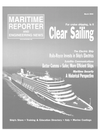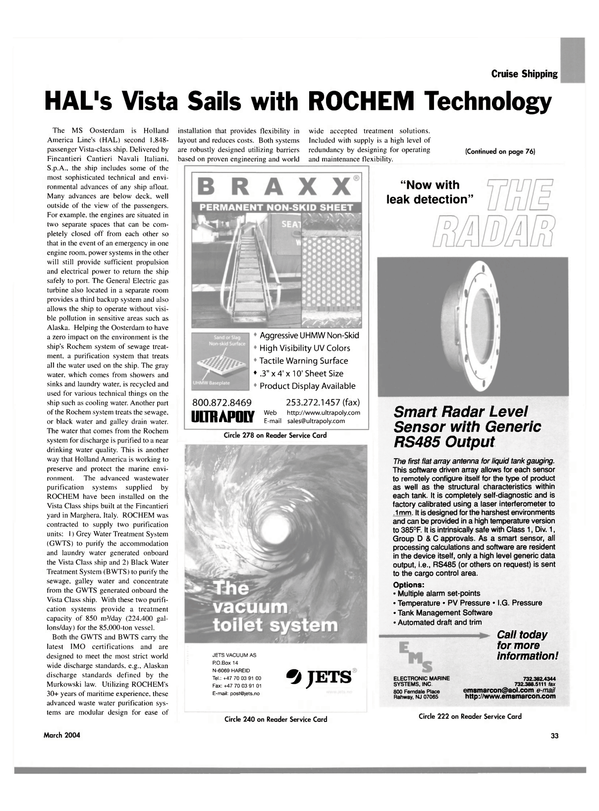
HAL's Vista Sails with ROCHEM Technology
The MS Oosterdam is Holland America Line's (HAL) second 1.848- passenger Vista-class ship. Delivered by Fincantieri Cantieri Navali Italiani, S.p.A., the ship includes some of the most sophisticated technical and environmental advances of any ship afloat.
Many advances are below deck, well outside of the view of the passengers.
For example, the engines are situated in two separate spaces that can be completely closed off from each other so that in the event of an emergency in one engine room, power systems in the other will still provide sufficient propulsion and electrical power to return the ship safely to port. The General Electric gas turbine also located in a separate room provides a third backup system and also allows the ship to operate without visible pollution in sensitive areas such as Alaska. Helping the Oosterdam to have a zero impact on the environment is the ship's Rochem system of sewage treatment.
a purification system that treats all the water used on the ship. The gray water, which comes from showers and sinks and laundry water, is recycled and used for various technical things on the ship such as cooling water. Another part of the Rochem system treats the sewage, or black water and galley drain water.
The water that comes from the Rochem system for discharge is purified to a near drinking water quality. This is another way that Holland America is working to preserve and protect the marine environment.
The advanced wastewater purification systems supplied by ROCHEM have been installed on the Vista Class ships built at the Fincantieri yard in Marghera, Italy. ROCHEM was contracted to supply two purification units: I) Grey Water Treatment System (GWTS) to purify the accommodation and laundry water generated onboard the Vista Class ship and 2) Black Water Treatment System (BWTS) to purify the sewage, galley water and concentrate from the GWTS generated onboard the Vista Class ship. With these two purification systems provide a treatment capacity of 850 m3/day (224,400 gallons/ day) for the 85,000-ton vessel.
Both the GWTS and BWTS carry the latest IMO certifications and are designed to meet the most strict world wide discharge standards, e.g., Alaskan discharge standards defined by the Murkowski law. Utilizing ROCHEM's 30+ years of maritime experience, these advanced waste water purification systems are modular design for ease of installation that provides flexibility in layout and reduces costs. Both systems are robustly designed utilizing barriers based on proven engineering and world wide accepted treatment solutions.
Included with supply is a high level of redundancy by designing for operating and maintenance flexibility.
The ROCHEM GWTS system is a low-pressure reverse osmosis (LPRO) membrane design that operates at less than 20 bars. Greywater is fed to a prefiltration unit to remove fibers and large particles (>100 mm) and then fed to the LPRO system that recovers roughly 85% of the feed as high quality water.
This purified water can be discharged overboard or utilized onboard for reuse.
The small amount of concentrate is further treated in the Bio-Filt system (BWTS). The GWTS was supplied with two identical units that can work in parallel or separately. The first stage system is supplied with ROCHF.M-FM modules that provide the main treatment of the greywater. The greywater is supplied to the first stage after going through prefiltration to remove fibers, hairs and large sediment from the feed that might block the flow. From the prefiltered greywater. the first stage will produce an amount of permeate which will go to a buffer tank for polishing, and the retentate is directed to the buffer tanks for the BWTS.
The second stage is supplied with ROCHEM-FM modules followed by a UV sterilizer to polish the permeate from the first stage. The concentration of BOD5. total suspended solids, fecal coliform, phosphorus, nitrate, nitrites and heavy metals are reduced further by the second stage below detectable limits.
The concentrate of this second stage is recycled to the inlet of the first stage.
The ROCHEM Bio-Filt system consists of a biological process of highly concentrated biomass combined with FM module technology utilizing UF membranes. This membrane bioreactor has a modular design and is manufactured as a multi-tank construction that is easy to adapt to different applications.
As wastewater is continuously fed to the system, the treated influent from the bioreactor is circulated through the FM module to separate the solids and organic matter that is returned to the bioreactor and the pure effluent is discharged overboard. The oxygen demand for the biological process is provided through air-injection using micro bubble technology.
Sensors measure the dissolved oxygen and biomass concentration to control the system to maintain a highly efficient biological degradation.
As part of the delivery process, Holland America Line. Fincantieri and ROCHEM organized the installation of laboratory equipment to monitor the influent and effluent quality of the GWTS and BWTS. An actual operating laboratory with trained chemists were boarded and traveled with the Oosterdam during its initial commercial itinerary in Europe. The performance test, designed in this manner, was able to evaluate the advanced waste water purification system under actual conditions with all of the variations in flow and contaminant concentration that the itinerary could offer. The key results of this effort confirmed a similar successful effort made on the first ship of the Vista class, the MS Zuiderdam.
Circle 22 on Reader Service Card
Read HAL's Vista Sails with ROCHEM Technology in Pdf, Flash or Html5 edition of March 2004 Maritime Reporter
Other stories from March 2004 issue
Content
- Bollinger Delivers Tidewater Supply Boat Jonathan Rozier page: 8
- World's Largest Dry Transport Vessel Delivered page: 10
- Port security: A Historical Perspective page: 12
- Delayed Enforcement of Change to "Shipper" Element page: 16
- MTSA: Another Key Layer of Port Security page: 17
- When Security is Made Simple page: 20
- Business Milestone for Vietnam page: 24
- "Made in Germany1 — a New High page: 24
- Miracle on Ice page: 26
- New President & CEO at Kvaerner Masa-Yards page: 28
- He's No Regular Joe page: 30
- Cruise Passenger Travel Grows 8 Percent; New York and Galveston Post Big Gains page: 32
- HAL's Vista Sails with ROCHEM Technology page: 33
- Royal Caribbean Takes Mariner of the Seas page: 34
- NorseMerchant Ferries Plans Service Upgrade page: 37
- Grimaldi Continues Fast Track Expansion page: 38
- Costa Places $450m Order With Fincantieri page: 40
- Losing ontact... Not an Option page: 44
- Ship Security Alert Systems (SSAS) page: 50
- GALILEO Lifts Off page: 52
- Icebreaker Uses Satellite to Break Through Communications Barriers page: 55
- Cellular Fixed Wireless Helps Deliver Mercy page: 57
- Homing in on Ships' Electrics page: 58
- Shipconstructor Chosen as Standard page: 61
- Contract for New Product Tanker Design page: 62
- BollFilter: 50 Years of Success and Counting page: 65
- The Corrosion Control Challenge page: 66
- Nippon Paint Restructures page: 69
- Metal Fusion Helps Stop Corrosion page: 69
- Maritime Security Professional Training page: 72
- Training the Trainer to Keep Knowledge Afloat page: 74


